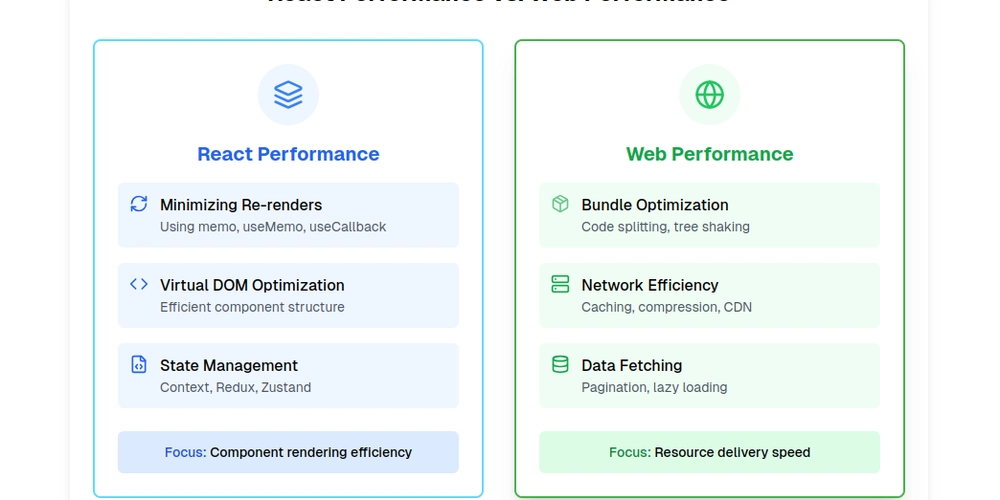React Performance vs. Web Performance: Understanding the Difference
When discussing performance optimizations, it’s easy to mix up React performance techniques with broader web performance considerations. While they’re related, they actually tackle two different layers: React Performance This area focuses on making your React application run smoothly by minimizing unnecessary re-renders and stabilizing the virtual DOM (React’s “Fiber tree”). A common example is props drilling: passing data multiple levels down can lead to extra re-renders if not handled carefully (e.g., by using Context or other state-management solutions). Too many re-renders can degrade the user experience because the browser has to repeatedly update the DOM. Web Performance On the other hand, web performance is framework-agnostic and centers on techniques to reduce overall page load times and deliver content more efficiently. This involves: Optimizing bundle sizes so users aren’t forced to download an excessive amount of JavaScript at once. Reducing the time-to-first-byte (TTFB) by efficiently handling server responses. Using pagination or data-fetching strategies to avoid over-fetching large amounts of data and slowing down initial renders. Essentially, you want to ensure that your users see content as quickly as possible and that your site remains responsive during interaction. Key Takeaways: React performance is about optimizing how and when your components update the DOM. Web performance is about delivering content and resources efficiently, no matter which framework or library you use. Both matter for a good user experience: a well-optimized React app with huge bundle sizes can still cause slow page loads, and a tiny, fast-loading site with poorly managed React renders can still feel slow once loaded.

When discussing performance optimizations, it’s easy to mix up React performance techniques with broader web performance considerations. While they’re related, they actually tackle two different layers:
React Performance
This area focuses on making your React application run smoothly by minimizing unnecessary re-renders and stabilizing the virtual DOM (React’s “Fiber tree”). A common example is props drilling: passing data multiple levels down can lead to extra re-renders if not handled carefully (e.g., by using Context or other state-management solutions). Too many re-renders can degrade the user experience because the browser has to repeatedly update the DOM.
Web Performance
On the other hand, web performance is framework-agnostic and centers on techniques to reduce overall page load times and deliver content more efficiently. This involves:
Optimizing bundle sizes so users aren’t forced to download an excessive amount of JavaScript at once.
Reducing the time-to-first-byte (TTFB) by efficiently handling server responses.
Using pagination or data-fetching strategies to avoid over-fetching large amounts of data and slowing down initial renders.
Essentially, you want to ensure that your users see content as quickly as possible and that your site remains responsive during interaction.
Key Takeaways:
React performance is about optimizing how and when your components update the DOM.
Web performance is about delivering content and resources efficiently, no matter which framework or library you use.
Both matter for a good user experience: a well-optimized React app with huge bundle sizes can still cause slow page loads, and a tiny, fast-loading site with poorly managed React renders can still feel slow once loaded.










































































































































































![[The AI Show Episode 142]: ChatGPT’s New Image Generator, Studio Ghibli Craze and Backlash, Gemini 2.5, OpenAI Academy, 4o Updates, Vibe Marketing & xAI Acquires X](https://www.marketingaiinstitute.com/hubfs/ep%20142%20cover.png)



























































































































![[FREE EBOOKS] The Kubernetes Bible, The Ultimate Linux Shell Scripting Guide & Four More Best Selling Titles](https://www.javacodegeeks.com/wp-content/uploads/2012/12/jcg-logo.jpg)



![From drop-out to software architect with Jason Lengstorf [Podcast #167]](https://cdn.hashnode.com/res/hashnode/image/upload/v1743796461357/f3d19cd7-e6f5-4d7c-8bfc-eb974bc8da68.png?#)






































































































.png?#)




.jpg?#)































_Christophe_Coat_Alamy.jpg?#)








































































































![Rapidus in Talks With Apple as It Accelerates Toward 2nm Chip Production [Report]](https://www.iclarified.com/images/news/96937/96937/96937-640.jpg)









































































































































